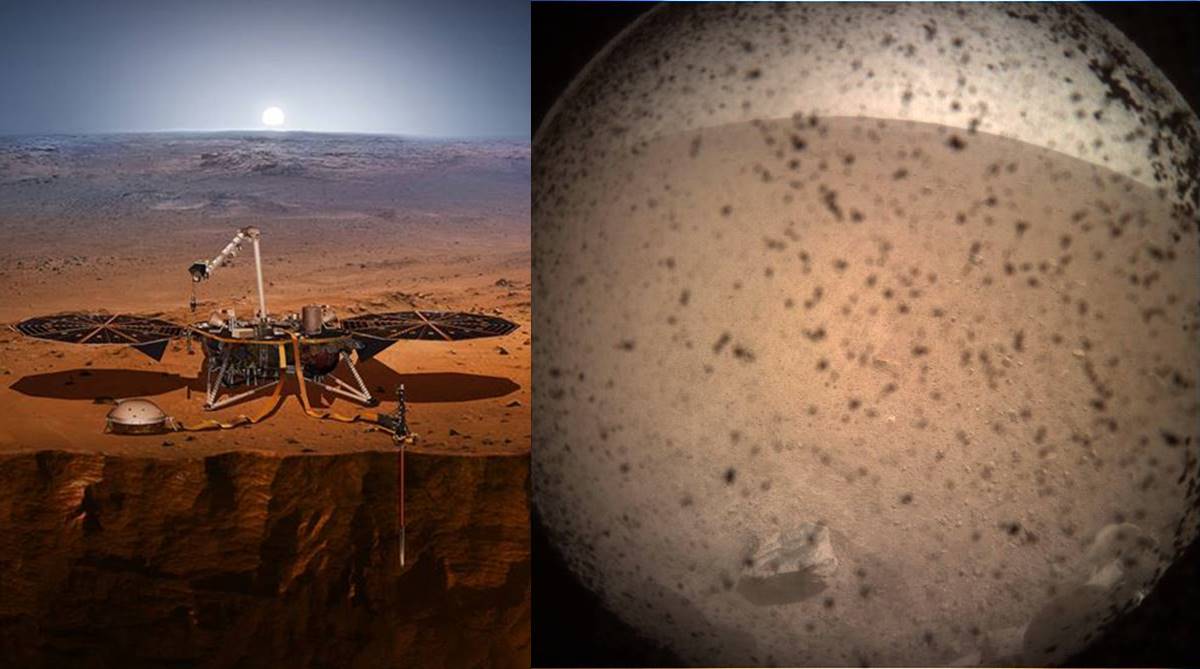NASA’s InSight finds biggest Marsquakes on Red Planet
This is the third major quake InSight has detected in a month: On August 25, the mission's seismometer detected two quakes of magnitudes 4.2 and 4.1.
The three-legged InSight spacecraft will study the deep interior of Mars to know how all celestial bodies with rocky surfaces, including Earth and the Moon, formed

The InSight spacecraft (left) and the first image (right) sent by it on November 26. (Photos: NASA)
NASA spacecraft InSight, designed to burrow beneath the surface of Mars, successfully touched down on the red planet Monday after an almost seven-month, 300-million-mile (458-million-kilometer) journey from Earth.
The Interior Exploration using Seismic Investigations, Geodesy and Heat Transport, or InSight, will study the deep interior of Mars to know how all celestial bodies with rocky surfaces, including Earth and the Moon, formed.
Advertisement
InSight will be operating on the planet on a two-year mission — one Martian year, plus 40 Martian days, or sols — until November 24, 2020.
Advertisement
Launched from Vandenberg Air Force Base in California May 5, InSight touched down on Monday, November 26, near Mars’ equator on the western side of a flat, smooth expanse of lava called Elysium Planitia, with a signal affirming a completed landing sequence at approximately noon PST (3 pm EST), NASA said in a statement.
“Today, we successfully landed on Mars for the eighth time in human history,” said NASA Administrator Jim Bridenstine. “InSight will study the interior of Mars, and will teach us valuable science as we prepare to send astronauts to the Moon and later to Mars. This accomplishment represents the ingenuity of America and our international partners and it serves as a testament to the dedication and perseverance of our team. The best of NASA is yet to come, and it is coming soon.”
According to NASA, scientists will be able to track radio signals from the stationary spacecraft, which vary based on the wobble in Mars’ rotation.
READ | NASA Curiosity rover completes 6 years on Mars
The three-legged spacecraft landed on the Maritian surface after being slowed by a parachute and braking engines, the space agency said. Updates came in via radio signals that take more than 8 minutes to cover the distance between Mars and Earth.
InSight is being followed to Mars by NASA’s two small experimental Mars Cube One (MarCO), the first CubeSats sent into deep space. The CubeSats launched on the same rocket as InSight.
The landing signal was relayed to NASA’s Jet Propulsion Laboratory (JPL) in Pasadena, California, via one of these MarCO CubeSats. NASA says the twin MarCOs have successfully carried out a number of communications and in-flight navigation experiments, and are now set in position to receive transmissions during InSight’s entry, descent and landing.
“We hit the Martian atmosphere at 12,300 mph (19,800 kilometers per hour), and the whole sequence to touching down on the surface took only six-and-a-half minutes,” said InSight project manager Tom Hoffman at JPL. “During that short span of time, InSight had to autonomously perform dozens of operations and do them flawlessly — and by all indications that is exactly what our spacecraft did.”
Flight controllers at JPL jumped with joy screaming, clapping and laughing as the news came in.
“Touchdown confirmed!” announced one of them.
Viewings were held at museums, planetariums and libraries, as well as the Times Square in New York.
InSight will begin to collect science data within the first week after landing. “At least two days after touchdown, the engineering team will begin to deploy InSight’s 5.9-foot-long (1.8-meter-long) robotic arm so that it can take images of the landscape,” NASA said in the statement.
“Landing was thrilling, but I’m looking forward to the drilling,” said InSight principal investigator Bruce Banerdt of JPL. “When the first images come down, our engineering and science teams will hit the ground running, beginning to plan where to deploy our science instruments.”
Within two or three months, Banerdt said, the arm would deploy the mission’s main science instruments — the Seismic Experiment for Interior Structure (SEIS) and Heat Flow and Physical Properties Package (HP3) instruments.
“That’s one giant leap for our intrepid, briefcase-sized robotic explorers. I think CubeSats have a big future beyond Earth’s orbit, and the MarCO team is happy to trailblaze the way,” said Joel Krajewski, MarCO project manager at JPL.
InSight is part of NASA’s Discovery Program, managed by its Marshall Space Flight Center in Huntsville, Alabama.
NASA last landed on Mars in 2012 with the Curiosity rover.
This is NASA’s eighth landing on the red planet. In all, the space agency has made nine attempts since the 1976 Viking probes. All but one of the touchdowns have been successful.
Advertisement